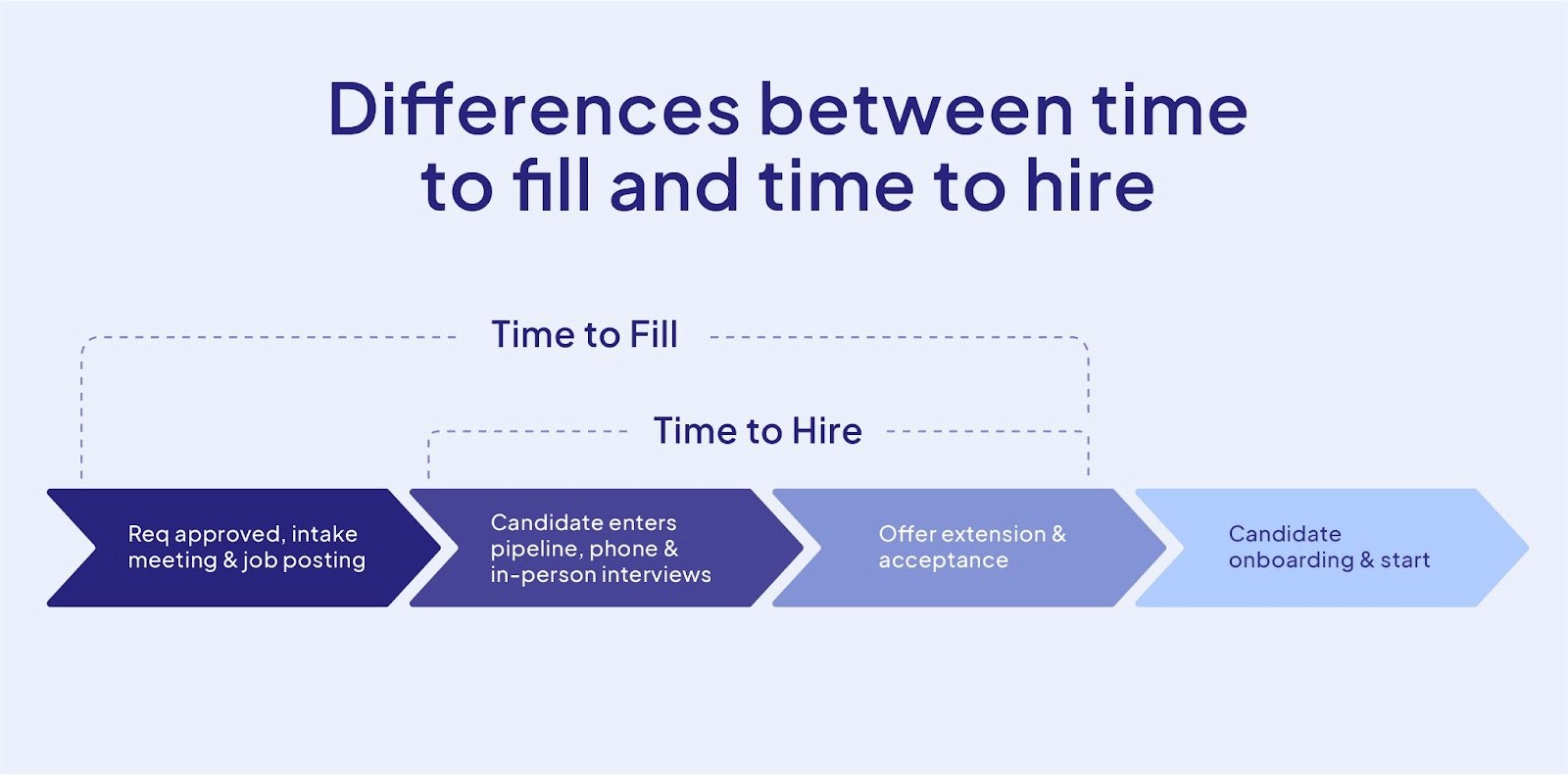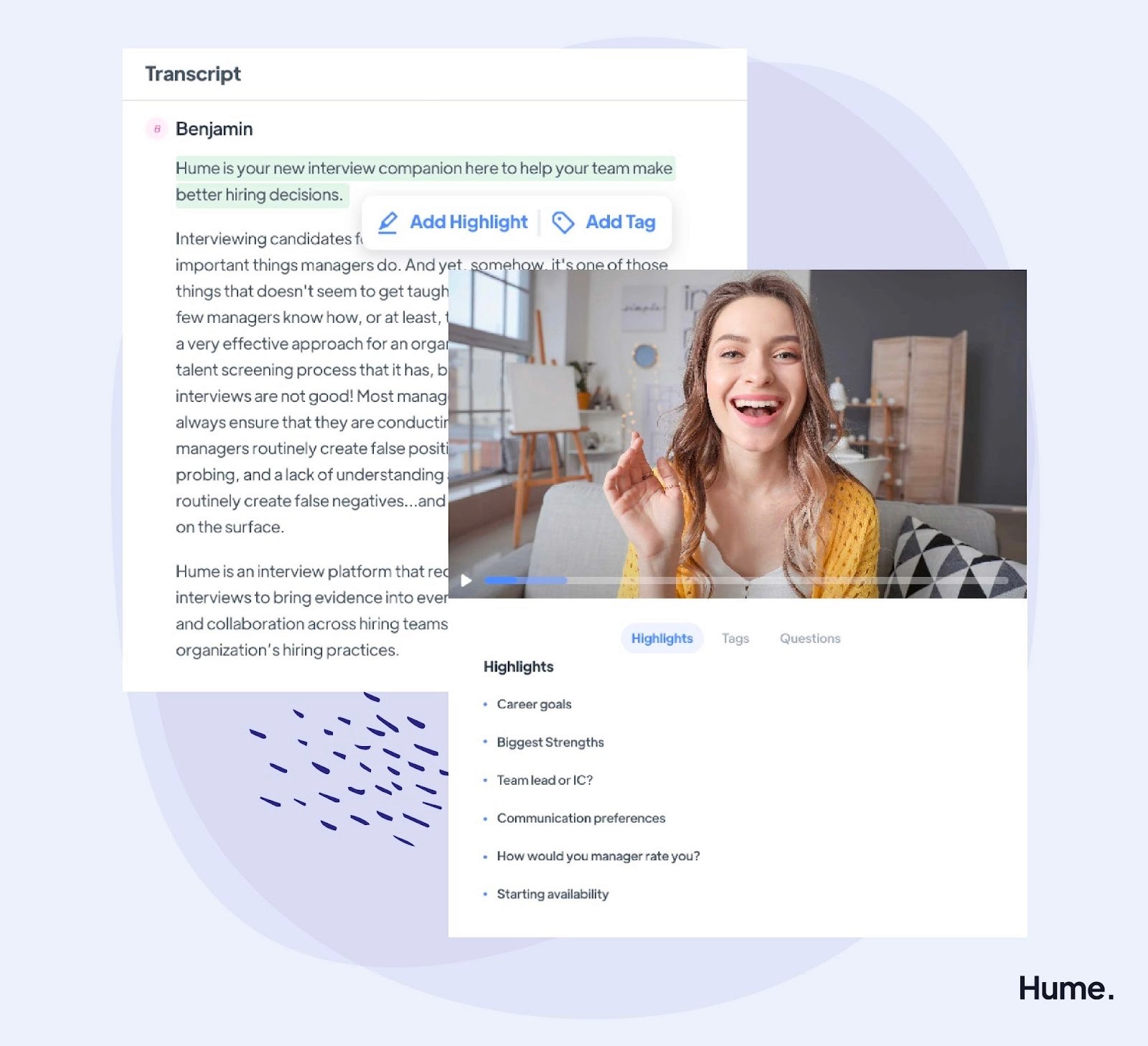Time to Fill vs. Time to Hire: Which Metric Is More Important?

2023
Hiring top talent comes with its share of challenges. On one hand, you want to hire top talent and provide a stellar candidate experience at each stage of the recruitment process. On the other hand, you can't afford to wait too long to find the perfect fit for your team. One way to address these issues is to measure and improve your time to fill and time to hire.
Both metrics reveal valuable insights into your hiring practices and have a direct impact on your company’s bottom line. They can also make or break the candidate experience, affecting your ability to attract talent.
So what’s the difference between time to hire and time to fill? And which metric matters most for your business? Read along for everything you need to know…

What is time to fill?
Time to fill is a recruitment metric that defines the average number of days it takes to fill a role, from the date a job requisition (which is a formal request to create or fill a job) is approved to the date a candidate accepts the offer.
Some companies use the date when a recruiter advertises a job opening as the starting point. Others take into account the date when hiring managers approve a job listing. In either case, this metric is measured by using calendar days, not working days, explains the Society for Human Resource Management.
The average time to fill is around 35 to 45 days, reports Oracle Netsuite. However, this number may vary depending on a company's size, industry, location, and other factors. The supply and demand for talent matters, too.
For example, it may take longer to fill a position in an industry facing talent shortages, such as business and finance, manufacturing, or information technology (IT). Fortune notes that companies worldwide are struggling to find skilled employees across the IT sector. This is partly due to the growing competition and partly due to the strict education requirements.
Why is time to fill important?
A long time to fill can deter candidates, making it harder to hire top talent. After all, who wants to wait for weeks to hear back from a prospective employee?
What's more, some of the top candidates spend as little as 10 days looking for work, HR thought-leader Dr. John Sullivan told ERE Media. Therefore, you may lose the chance to have them on your team if you take too long to make a hiring decision. The longer your time to fill is, the more likely you are to miss out on top talent.
A slow hiring process can affect your company's bottom line, too.
Without the right people, you may not be able to take on extra work, launch a new product, or meet project deadlines. This could result in lost revenue and missed opportunities, especially if you're running a startup or small business. As many as 14% of startups fail simply because they don’t have the right team, reports CB Insights.

What is time to hire?
Organizations must also consider the amount of time it takes to hire a new employee, starting from the date a candidate applies for a role to the date they accept the job offer. This metric is known as time to hire and can tell a lot about the efficiency of your HR team.
The median time to hire is 33 to 49 days, according to LinkedIn. Companies hiring for engineering, research, business development, finance, or project management roles need 46 to 49 days to make a decision.
The company’s size and industry matters as well. About 70% of large organizations need around 43 days to hire for software development roles. The remaining 30% have an average time to hire of less than a month. Smaller companies, by comparison, need about 29 days to fill a development role.
What does it mean for your business?
A shorter time to hire often translates into a more effective recruitment process, as well as a better candidate experience.
But quality of hire can be even more important. Depending on the job requirements, it may be worth waiting a few more weeks to find the right person rather than risk making a bad hire.
Time to fill vs. time to hire
To keep it simple, the time to hire rate indicates the number of days it takes to hire someone following their application for a job vacancy. The time to fill rate, by comparison, covers the entire recruitment process — from the moment you greenlight a new job opening to the moment someone accepts your offer and comes on board.
Let's say you're looking for a web designer to join your team. A job requisition is approved on March 5. John, a potential candidate, submits his application on March 10. You read his resume, schedule one or more interviews, and make him an offer. He accepts it and signs the employment contract on April 15.
In this case, the time to hire is 35 days. The time to fill, on the other hand, is 40 days.
However, John may need more or less time to think about your offer. Plus, there could be delays in the interview process, depending on its complexity. On top of that, it may take you longer to make a decision if you are interviewing multiple candidates. Any of these factors can affect both your time to hire and time to fill.
While these metrics may look similar, each can provide different insights into your hiring process.
By tracking them separately, you will be better able to determine the efficacy of your HR team and its impact on your talent pipeline. This approach would also allow you to identify weaknesses in your talent acquisition process and how to improve the candidate experience.

For starters, both metrics can offer valuable insights into your recruitment practices, helping you:
Improve the candidate experience
Reduce cost-per-hire
Determine how long it takes to fill a role
Identify the resources needed to attract top talent
Optimize your recruitment practices
Benefits of time to fill
The time to fill rate provides a bigger picture of the hiring process, as it covers a longer period and may include additional steps, such as candidate onboarding, after the job offer is accepted. The time to fill metric can also help you determine whether your job ads are targeted at the right people.
With that in mind, you can take the steps needed to improve your hiring process and identify the best candidates.
Benefits of time to hire
The time to hire metric, on the other hand, can serve as an indicator of competition in the labor market. Plus, it’s one of the main factors that influence your ability to attract talent.
After all, many candidates go through an endless interview process and get nothing in return.
BBC Worklife cites a software engineering manager named Mike Conley who attended several job interviews with multiple companies, but without success. Some eventually decided to hire internally, whereas others told him they had to delay hiring because of the novel coronavirus. One company interviewed him three times and then scheduled another six interviews.
These issues can result in a lengthy hiring process and affect your company’s image and bottom line. You may find it difficult to attract candidates, build a strong team, and reduce recruitment costs. A shorter time to hire will likely have the opposite effect, leading to lower costs and a more efficient talent acquisition process.
Which metric is more important?
Filing an open role often takes longer than a month. As discussed earlier, both time to hire and time to fill vary from company to company and depend on a multitude of factors, including:
Industry-specific processes
Company size and reputation
Recruitment practices
Job requirements
The level of competition in the labor market
Supply and demand
Technological advances
Labor market regulations
For example, nearly 68% of recruiters are now using social media to find talent. Some leverage artificial intelligence and other breakthrough technologies to identify, screen, and sort candidates. These hiring practices have the potential to speed up the recruitment process and improve the candidate experience.
But which metric is more important? Should you focus on the time to fill or time to hire rate? The answer depends on the factors listed above, especially your company size and industry.
Generally, large organizations and companies in highly regulated industries spend more time on reference checks, screenings, and other hiring procedures. Plus, they typically receive a higher number of applications than startups and small or medium-sized businesses. As a result, they take longer to hire.
If that's your case, it makes sense to focus on reducing your time to fill rate. This can be done by using recruiting software, automating candidate outreach, conducting online interviews, and more.
Small and medium-sized businesses, on the other hand, may benefit from a lower time to hire rate. These companies cannot afford to wait for weeks or months to fill a role because they would end up losing time and money
When you have a small team, it's in your best interest to get a helping hand as quickly as possible. Chances are, you'll receive plenty of applications, but you could miss out on top talent if you take too long to make a decision.
Analyze and improve your hiring practices
Regardless of your company size or industry, a slow hiring process can affect your ability to attract talent and deter potential candidates.
A 2019 survey found that more than 80% of employers have been ghosted by potential hires. Some candidates stopped replying to recruiters, while others accepted the job but refused to sign the paperwork. The longer you wait to hire someone, the higher your chances of having a similar experience.
Robert Half reports that 19% of job seekers lose their interest in a role if they don't hear back within a week after the first interview. And approximately 43% of candidates are not willing to wait longer than two weeks to hear back from recruiters after an interview. As a result, they choose to stay in their current jobs or seek new opportunities.
Nearly half of those who go through this experience end up ghosting the employer. About one-third will vent on social media, while 26% leave negative feedback on review websites. Others simply blacklist the company in question.
Given these aspects, it makes sense to analyze your hiring process and find ways to improve it. A good starting point is to take a closer look at your time to fill and time to hire rates.
First, try to identify the most time-consuming steps. For example, you may realize that your job ads are not as effective as you thought they would be. If that's the case, you could use A/B testing to measure the reach and efficacy of your job adverts and reduce time to fill.
You could also study other companies in your industry. Try to determine how long it takes them to hire staff based on their size, location, job requirements, and other factors. Meanwhile, focus on building a talent pipeline so you can find potential hires more easily whenever there's an open role in your firm.
What matters most is to keep track of each stage in the recruiting process. Decide on an ideal and maximum number of days for each stage and then try to figure out where you're falling short.
If, say, your interview process is too long, consider asking candidates to complete a trial project or take a test rather than go through multiple interviews. Another option is to use group interviews, as it would allow you to evaluate several applicants at once.
Leverage the power of technology to streamline your interview process
As you can see, there's a lot that goes into the recruitment process. You need to consider your time to hire and time to fill, as well as other metrics, such as time to start, time in process, quality of hire, and offer acceptance rate. The application drop-off rate and interview-to-hire ratio are just as important.
One way to track and improve these numbers is to use online tools that leverage the latest technology. For example, recruitment software programs can automate the most time-consuming parts of the hiring process, from candidate screening to interview scheduling.
Then there's Hume, our talent intelligence platform, which makes it easier to structure, record, and transcribe your interviews — ensuring a fair candidate experience. Why waste valuable time trying to remember who said what and taking notes when you can have everything done for you?

With Hume, your only job is to focus on the candidate and ask the right questions. This will not only reduce your time to fill but also drive efficiency across your hiring team and lead to better decisions. Moreover, it can improve collaboration between teams and departments and provide insight into your hiring practices.
Interested to find out more? Join our waiting list and follow our LinkedIn page to get early access to the latest interviewing technology.



